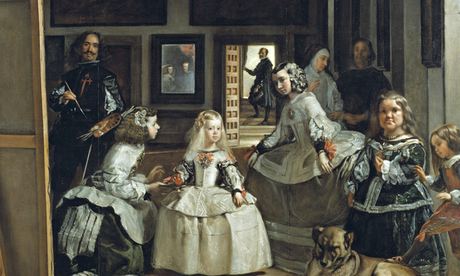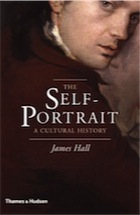There is never a dull passage in James Hall's revelatory study of the way in which artists – whether out of salvation, self-scrutiny or vanity – have captured themselves down the years

In the picture … A detail from Diego Velázquez's Las Meninas
"The moment when a man comes to paint himself – he may do it only two or three times in a lifetime, perhaps never – has in the nature of things a special significance." So Lawrence Gowing wrote, in an introduction to a 1962 exhibition of British self-portraits. And he is right: self-portraits, whether of men or women, have a particular call on our attention.
Take Käthe Kollwitz's etching Self-portrait with Hand to her Forehead, reproduced in James Hall's new book. The head and hand fill the entire plate, leaving no room for anything else. The heavy, repeated lines form dark shadows on and around the head, while the eye under the hand is obliterated by darkness. Yet her face presses forward, as if she were leaning on the kitchen table, offering us, with inescapable intimacy, a memory of the suffering and sadness she witnessed in the poor quarter of Berlin where her husband worked as a doctor. The viewer need know nothing of this: it is all there in her look.
 Whatever stance they promote, be it pompous or playful or merely pleasing, self-portraits have much to say. They can show success or indulge in self-mockery; advertise a new aesthetic or celebrate a marriage. "Certainly he likes his face; what is wrong with that?" writes Gowing of the self-portraitist (again confining his thoughts to his own gender). "Naturally he is not without vanity, without a little conceit few men could bear their mirrors of their lives.
Whatever stance they promote, be it pompous or playful or merely pleasing, self-portraits have much to say. They can show success or indulge in self-mockery; advertise a new aesthetic or celebrate a marriage. "Certainly he likes his face; what is wrong with that?" writes Gowing of the self-portraitist (again confining his thoughts to his own gender). "Naturally he is not without vanity, without a little conceit few men could bear their mirrors of their lives.
Moreover, the painter's opinion of himself is a part of his equipment. He needs his conceit, as an opera singer does. Pride and a certain exultation nourish any physical skill." Again, the accuracy of this is borne out by illustrations in Hall's book; most memorably so by James Barry's cool glance, or by the fresh and original pose adopted by the youthful Reynolds as he shades his eyes with his raised arm. But there is much else going on in The Self-Portrait: A Cultural History, as it departs radically from the popular belief that the sole purpose of self-portraits is to bring us into contact with the artist's soul.
More
Take Käthe Kollwitz's etching Self-portrait with Hand to her Forehead, reproduced in James Hall's new book. The head and hand fill the entire plate, leaving no room for anything else. The heavy, repeated lines form dark shadows on and around the head, while the eye under the hand is obliterated by darkness. Yet her face presses forward, as if she were leaning on the kitchen table, offering us, with inescapable intimacy, a memory of the suffering and sadness she witnessed in the poor quarter of Berlin where her husband worked as a doctor. The viewer need know nothing of this: it is all there in her look.
 Whatever stance they promote, be it pompous or playful or merely pleasing, self-portraits have much to say. They can show success or indulge in self-mockery; advertise a new aesthetic or celebrate a marriage. "Certainly he likes his face; what is wrong with that?" writes Gowing of the self-portraitist (again confining his thoughts to his own gender). "Naturally he is not without vanity, without a little conceit few men could bear their mirrors of their lives.
Whatever stance they promote, be it pompous or playful or merely pleasing, self-portraits have much to say. They can show success or indulge in self-mockery; advertise a new aesthetic or celebrate a marriage. "Certainly he likes his face; what is wrong with that?" writes Gowing of the self-portraitist (again confining his thoughts to his own gender). "Naturally he is not without vanity, without a little conceit few men could bear their mirrors of their lives.Moreover, the painter's opinion of himself is a part of his equipment. He needs his conceit, as an opera singer does. Pride and a certain exultation nourish any physical skill." Again, the accuracy of this is borne out by illustrations in Hall's book; most memorably so by James Barry's cool glance, or by the fresh and original pose adopted by the youthful Reynolds as he shades his eyes with his raised arm. But there is much else going on in The Self-Portrait: A Cultural History, as it departs radically from the popular belief that the sole purpose of self-portraits is to bring us into contact with the artist's soul.
More
No comments:
Post a Comment